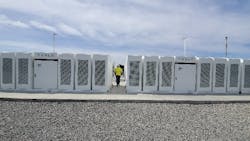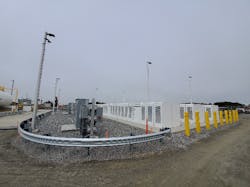Challenges and Solutions of Renewable DER Integration
The decarbonization of the energy system is one of the biggest challenges facing our world and National Grid has a critical role to play in the acceleration toward a cleaner future. The electric and natural gas utility that supplies energy to more than 20 million people, recently announced a new net-zero target to reduce its own direct greenhouse gas emissions by 2050. This entails reducing greenhouse gas emissions in generation, transportation, and heat, while integrating renewable distributed energy resources (DERs), which heavily contribute to the reduction of greenhouse gas emission in the generation sector.
Traditionally, the electric power system was designed to deliver power from wholesale power plants to transmission and then to the consumers on the distribution network. With the high penetration of DERs, the direction of power flow is changing, posing challenges to system protection, operation, power quality, and more. However, these challenges are being resolved by properly upgrading the electric power system.
Despite the engineering challenges, renewable DERs provide benefits that include, but are not limited to, improved consumer level resiliency, lower system losses, reduced demand charges, and reduced greenhouse gas emissions. This article presents some of the technical challenges and potential solutions associated with the integration of renewable DERs including energy storage and the electric power system. It concludes with energy storage-specific benefits to meet transmission system reliability needs.
1. Power system protection:
- Adding DERs to the distribution network desensitizes the existing protective relaying because the fault current contribution from the substation to the fault decreases. This relay desensitization can cause protection miscoordination that adversely impacts system reliability indices. Since utilities have no control over the operation of third-party owned DERs, the impact of system protection is becoming paramount. Adaptive relaying can be considered as a potential solution. This type of relaying allows relay settings to be remotely adjusted based on the available DERs in the distribution feeder. Communication is needed to enable this type of protection.
- Inverter-based DERs generate low fault current. With not enough fault current capability available, the inverse time over current relays will not be able to detect all faults. Voltage controlled, voltage supervisory, or adaptive relaying can be used to mitigate this issue.
- Utilities are concerned that the increasing amount of DERs with advanced grid support functionalities like voltage control, frequency control, ride through, and other measures will desensitize the anti-islanding protection of DERs. Anti-islanding protection is designed to shut down the DER within two seconds in an island condition. This is necessary for the safety of utility crews. Preliminary studies show that the impact of voltage regulation and ride through on the anti-islanding protection is minimal. However, further studies are needed to determine this adverse impact on multiple DER cases.
- Reverse power flow at the substation. If there is no ground source on the high side of the substation transformer, 3V0 protection is a good solution to detect line-ground faults on the high side. Otherwise, the directional overcurrent relay should be able to detect all faults on the high side of the substation transformer.
2. Power quality:
- Intermittent nature of wind and solar generation causes voltage fluctuation on the distribution system. This can adversely impact the life of voltage regulators and load tap changers. According to the recent version of the IEEE 1547-2018 standard, the voltage regulation function of the DER will be available to mitigate potential voltage fluctuation issues. Energy storage can also be considered as a potential solution for this issue.
3. Lower net load:
- In some parts of the world, we are seeing lower net load during the day than the night. This is because of the high penetration of photovoltaic (PV) generation. This is causing significant challenges for system operators because these PV resources are nondispatchable and cannot be remotely controlled during switching. Remote control over these resources along with energy storage is being considered as a solution for this issue.
Energy Storage-Specific Benefits to Meet Transmission System Reliability Needs
National Grid is actively pursuing energy storage on its network to cost-effectively resolve transmission needs and provide network transmission and distribution (T&D) reliability benefits. National Grid has many energy storage initiatives in development, including the Nantucket Island Battery Energy Storage System (BESS).
National Grid recently commissioned the BESS, a 6-MW, 48-MWh facility, that reliably defers capital investment, and, along with complementary facilities, resolves reliability issues affecting services to the island of Nantucket. National Grid is working with the Pacific Northwest National Laboratory to evaluate the full range of benefits that the Nantucket storage system can provide. National Grid has studied other parts of our transmission system and concluded that energy storage can be used to cost-effectively address transmission needs in specific circumstances.
More generally, National Grid has found that energy storage can offer a variety of benefits and challenges. With respect to benefits, an energy storage resource:
- By itself, or in conjunction with power flow controller devices, may be the least-cost solution to address case-specific reliability issues on the transmission network.
- Can provide power quality grid support services (for example, Volt/VAR, frequency/Watt).
With respect to challenges:
- Cybersecurity for integration to the energy management system (EMS) presents challenges as some energy storage inverters are manufactured outside the country. Cybersecurity standards need to be frequently updated to maintain the resiliency of the electric grid.
- Some RTO/ISO regional planning processes do not consider energy storage as a potential solution to identified reliability needs.
- Because of the variety of storage inverter designs and proprietary information protected by the manufacturers, lack of standard storage models poses challenges to the utilities to properly model energy storage for their planning studies.
Renewable DERs will play a key role in National Grid's pathway toward achieving net-zero greenhouse gas emissions by 2050. Despite some engineering challenges, National Grid believes that clean energy generation will play a key role in shaping the future of the electric power system.
About the Author
Babak Enayati
Dr. Babak Enayati joined National Grid, Waltham, Massachusetts, in 2010 and is currently the manager of the technology deployment team, which is charged with the development and implementation of the transmission network modernization strategy. His responsibilities also include DER interconnections, power system protection, control of microgrids, and smart grids. He also serves as the vice chair of the IEEE Standards Coordinating Committee 21 (SCC21) and IEEE 1547, Standard for Interconnecting Distributed Energy Resources with Electric Power Systems. He is a registered professional engineer (PE) in the state of Massachusetts.

